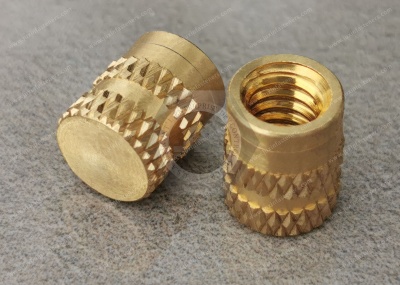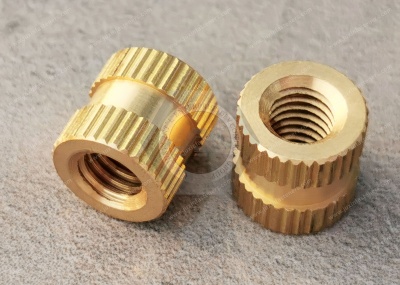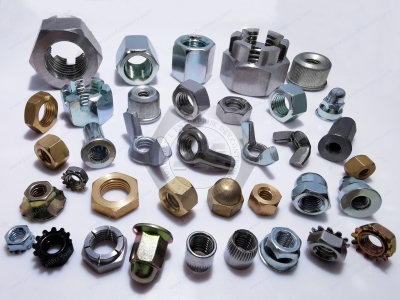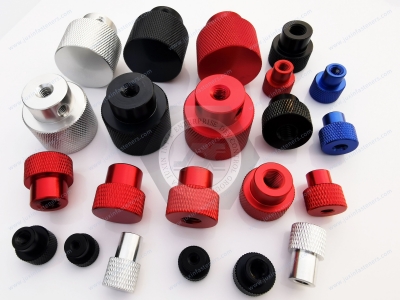Call Us
+86 136 6007 9809
Call Us
+86 136 6007 9809
Jan. 19, 2024
Tapered Heat-Set Inserts fasteners for Plastic application industry solutions
A brass nut is made of copper (generally lead brass, such as H59 and H62) and nuts. Our daily contact with brass nuts is mainly hexagonal nuts or bolts with other brass nuts. Brass nuts have the advantages of not being easy to rust or corrosion, easy thermal conductivity, and conductivity generally used for rust, high temperature, electrical conductivity, thermal conductivity, and other uses of the environment, such as faucets, valves, electrical switches, etc. As mentioned earlier, injection molding is another significant use, as it is heated and embedded into the plastic parts inside or directly in-mold injection molding.
A brass nut is made of nuts and uses copper materials (generally leaded brass, such as H59 and H62). We mainly use hexagonal nuts or bolts with other brass nuts in our daily lives.
So why use brass nuts in daily production activities? Because the brass nut is not easy to rust, corrosion, easy thermal conductivity, and conductivity, etc., it is generally used for rust, high temperature, conductivity, thermal conductivity, and other uses of the environment, such as faucets, valves, and electrical switches. Brass knurled nut Another significant use is injection molding, heating embedded in plastic parts, or direct mold injection molding.
Hot press injection molding or cold press injection molding brass nuts:Brass has good thermal conductivity, such as the use of heated brass nuts embedded; on the one hand, the brass nut can quickly become hot to speed up the work efficiency; on the other hand, the heated brass nut can be promptly heat conduct to the plastic parts, so that the plastic hole peripheral soft, conducive to the pressure into the hole; then, if the use of mold injection molding effect will be if what? As we all know, PA/NYLOY/PET melting points are 200 ° C or more; brass nuts are hot melt into the plastic parts after the temperature quickly becomes high; after injection molding, the plastic body quickly cools and crystallized hardening, if the temperature of the brass nuts is still in the high temperature, the result will be what? Bright, you must have guessed. The result is that the brass nut and plastic parts are in contact with the development of looseness or cracks. So, injection molding is used in brass nuts rather than steel nuts.
Applied in injection molding in the shape of the brass nut is generally pressed with various forms of pattern round, mold hot melt is usually cylindrical, hot or cold pressed into the shape of the copper screw have a specific taper or with a barbed shape, as to why is the taper or barbed shape? The purpose is to increase the torsional strength of brass rolled nuts in plastic.


What is an embedded nut?
Embedded nuts are brass nuts made from various embossed wires (generally leaded brass, such as H59, 3604, 3602). Precision automatic lathes process the embedded knurled brass nuts we come into contact with daily.
Embedded knurled brass nuts are the primary mode of operation is injection molding, heated and embedded in plastic parts or direct mold injection, if the mold injection, PA/NYLOY/PET melting point are in the 200 ° C or more, embedded in the yellow steel nut is hot melt into the plastic parts after the temperature quickly becomes high, injection molding, the plastic body quickly cooled and crystallized hard, if embedded in the temperature of the brass nut is still in the high temperature, it may lead to the brass nut, the brass nut, the brass nut, the brass nut, the brass nut, the brass nut, the brass nut, the brass nut. If the embedded brass nut is still at a high temperature, it may lead to loosening or cracks in the places where the brass nut contacts the plastic parts. This is why brass nuts are used in the injection molding of embedded brass nuts instead of carbon steel nuts.
The embedded brass nut external knurling has two molding methods. One is the use of brass raw material drawing shaping and then on the production equipment, generally this way of drawing patterns for the straight line; the other is the use of round copper material directly in the production process while tapping the nut side of the knurling so that the processing mode can produce some non-standard size knurling brass nuts, embedded brass nut embossed shape can be chosen by the user, such as mesh, eight embossed shapes can be used with the user, such as the mesh, eight embossed shapes can be used with the user, such as the mesh, eight embossed shapes can be used in the production process. The user can choose the embossed shape of the embedded brass nut, such as mesh, eight embossed, herringbone embossed, and other knurling patterns.
Knurled brass nuts are mainly used for hardware springs, shaped springs, gift springs, battery spring plates, spring antennas, key rings, phosphor bronze springs, CNC automatic lathe-turned parts (copper turning parts, iron hanging parts, aluminum turning parts), hardware stamping parts, electronic hardware, iron shafts, single-flowering shafts, multi-flowering shafts, iron pins, non-standard screws and nuts, connecting parts, fasteners, wire molding (metal wire name card clips, landing gear for model airplanes, S-hooks, R-type pins, triangular pins, etc.). Hooks, R-type pins, triangular buckles, D-type buckle) and other hardware products belonging to the brass nut series.
According to different methods, Brass nuts, pre-embedded nuts, inlaid brass nuts, or plastic embedded nuts are divided into hot melt brass nuts, hot pressing brass nuts, embedded brass nuts, and ultrasonic brass nuts. This product is widely used in cell phone shells/notebook shells/injection molded parts/plastic parts of the embedded parts, as an internal thread, and generally embossed on the outside. To prevent sliding.
What do you mean by embedded brass nuts?
The embedded brass nuts use copper (generally lead brass, such as H59, H62, etc.) to produce nuts. Our daily contact with the buried copper nuts is mainly hexagonal nuts or bolts with other buried brass nuts.
Why are buried brass nuts used in daily production activities? Because the buried brass nut does not easy to rust, corrosion, easy thermal conductivity and conductivity, and other advantages generally used for rust, high temperature, conductive, thermal conductivity and other uses in the environment, such as faucets, valves, electrical switches, mechanical assembly, and so on.
1. Nut is the nut screwed together with the bolt or screw used to play a role in fastening parts; all manufacturing machinery must be used in an original. There are many types of nuts; we commonly have national standard, British standard, American standard, and Japanese standard nuts. According to the different materials, nuts are divided into carbon steel, high strength, stainless steel, plastic brass, and other significant types and divided into ordinary, non-standard, (old) national standards, the new, American, British, and German standards. Different sizes, German standards with M (M8, M16), American, and British systems are expressed in fractions or # specifications (such as eight #, ten #, 1/4, 3/8).
2. Nuts are mechanical equipment closely connected parts through the inner threads, the same specification nuts and screws to be connected; for example, M4-0.7 nuts can only be used with M4-0.7 screws with (in the nut, M4 refers to the inner diameter of the nut is about 4mm, 0.7 refers to the distance between the two threaded teeth for 0.7mm); the same for U.S. system products, such as the 1/4-20 nuts can only be paired with 1/4-20 screws (1/4 means the inside diameter of the nut is approximately 0.25 inches, and 20 means that in each inch, there are 20 teeth).
Tapered Heat-Set Inserts for Plastic: The tapered shape makes it easier to guide these inserts into a hole during installation. Use a drill bit to create a straight hole, then taper the top half. Heat inserts with a soldering tip to melt the plastic when installed. As the plastic cools, it solidifies around the knurls and ridges on the insert for excellent resistance to torque and pull-out.
Made with lead, brass inserts are more robust than aluminum and other brass alloys but not as strong as 303 stainless steel inserts. They have good corrosion resistance.
Aluminum inserts are 70% lighter than brass and stainless steel inserts, have good corrosion resistance, and are lead-free. Therefore, they can be safely recycled.
Three hundred-three stainless steel inserts are more robust than brass and aluminum inserts, have excellent corrosion resistance, and are lead-free. Since they’re lead-free, they can be safely recycled.
Inserts that meet ASTM standards comply with specifications for material quality.
Heat-Set Inserts for Plastic: Install these inserts into plastic parts to create a secure fastener base. Also known as Chevron-headed inserts, they are often used to strengthen mounting holes on brittle plastics, such as on 3D-printed parts. Unlike plastic threads, which wear down repeatedly, they hold their shape over a long life. Press inserts into straight holes drilled, printed, or molded into plastic parts, then heat them with a soldering tip to melt the surrounding plastic. As the plastic cools, it fuses to the sharp, diagonal ridges around the inserts, which withstand torque and prevent them from being pulled out. The interior is fully threaded to access the threads from both sides of a through-hole.
Flanged inserts have a more comprehensive end than standard inserts, which gives them a larger load-bearing surface and makes them harder to pull out. The flange also gives you a larger contact area for soldering. When threading into the flanged side, these inserts prevent over-tightening, which can cause brittle plastic to crack.
Made with lead, brass inserts are more robust than aluminum and other brass alloys but not as strong as stainless steel inserts. They have good corrosion resistance.
Aluminum inserts are 70% lighter than brass and stainless steel inserts, have good corrosion resistance, and are lead-free. Therefore, they can be safely recycled.
Stainless steel inserts are more robust than brass and aluminum inserts, have excellent corrosion resistance, and are lead-free. Since they’re lead-free, they can be safely recycled.
Male Threaded Heat-Set Inserts for Plastic: With the male threaded end on these inserts, mount components directly to plastic parts. The other end has two bands of diagonal knurls that face opposite directions to resist torque and pulling out. Heat the inserts on a hot plate, then press the knurled end into a straight hole. The heat melts the surrounding plastic, and as it cools, it hardens around the knurls.
Compared to 3D printed or plastic male threads that wear down when used repeatedly, these inserts are brass, creating a more substantial fastening base. Brass is also corrosion resistant, nonmagnetic, and can be used as an electrical contact.


Turning technology:Brass nut thread turning technology: in the workpiece on processing internal and external threads of the method, mainly cutting and rolling processing of two types. The application of the principle of thread can be traced back to 220 B.C. Greek scholar Archimedes created the spiral water-lifting tool. In the 4th century A.D., the Mediterranean coastal countries began to apply the principle of bolts and nuts to the presses used in winemaking. At that time, external threads were made by wrapping a piece of string around a cylindrical bar and carving it according to this mark. Internal threads, on the other hand, were often formed by hammering a softer material around the external thread, and around 1500, the Italian Leonardo da Vinci made a drawing of a screw thread. Leonardo da Vinci sketched the thread processing device; there has been the application of female screws and exchange gear processing different pitch thread ideas. Since then, the mechanical cutting of threads in the European watch manufacturing industry has developed. In 1760, the British J. Wyatt and W. Wyatt brothers received a patent for a particular device to cut wood screws. In 1778, the British J. Ramsden manufactured a worm gear drive thread-cutting device that could process a long thread with very high precision. 1797, the British Mozley, H. in the lathe improved by him, using the mother screw and exchange gear processing different pitch threads. In 1797, the Englishman Mozley, H. in the lathe, improved by him the use of female screws and exchange gear by turning other pitch metal threads and laid the primary method of turning threads. In the 1820s, Mozley made the first batch of thread-processing taps and plate teeth. Early 20th century, the development of the automobile industry to further promote the standardization of the screw threads and a variety of precision ﹑ the development of efficient screw threading methods, a variety of automatic opening plate teeth heads, and mechanical shrinkage A variety of robotic tapping head and automatic shrinkage taps have been invented, thread milling began to be applied. In the early 30s, there was the emergence of thread grinding. Thread rolling technology in the early 19th century on patent, but because of the mold manufacturing difficulties, the development is very slow until the Second World War period (1942 ~ 1945) due to the need for arms production and the development of thread grinding technology to solve the problem of precision mold manufacturing, only to obtain rapid development.
1. Thread cutting generally refers to using molding tools or abrasives on the workpiece thread processing methods, mainly turning, milling, tapping, socket, grinding, grinding, and cyclone cutting. Turning, milling, and grinding threads, the workpiece every turn, and the machine tool transmission chain to ensure that the turning tool, milling cutter, or grinding wheel along the axial direction of the workpiece accurately and uniformly moves a lead. In tapping or socket, the tool (tap or plate teeth) and the workpiece for relative rotation, and by the first formed thread groove to guide the tool (or workpiece) for axial movement. Thread turning (thread turning) in the lathe turning threads can be used to form a turning tool or thread comb tool (see thread processing tools). Thread turning with molding cutter, due to its simple tool structure, is a single piece and small batch production of threaded workpieces commonly used methods; thread comb spinning threads, high productivity, but the tool structure is complex, only for the ﹑ high-volume production of turning delicately threaded workpieces of short threads. Ordinary lathe turning trapezoidal thread pitch accuracy can only reach the 8 ~ 9 level (JB2886-81, the same below); in the specialization of the thread lathe processing thread, productivity or accuracy can be significantly improved.
2. Thread milling (thread milling) in the thread milling machine with a disk milling cutter or comb milling cutter for milling. The disk milling cutter is mainly used for milling screws, worms, and other workpieces on the trapezoidal external thread. Comb milling cutter for milling internal and external ordinary threads and taper threads; as a result of multi-edge milling cutter milling, the length of its working part is greater than the length of the thread being processed, so the workpiece only needs to be rotated 1.25 ~ 1.5 turns can be processed to complete the production rate is very high. Thread milling pitch accuracy can generally reach 8 ~ 9 level, with a surface roughness of R 5 ~ 0.63 microns. This method suits batch production of general precision threaded workpieces or roughing before grinding.
3. Thread grinding is mainly used for processing precision threads of hardened workpieces on thread grinding machines and is divided into two kinds of grinding wheels according to the different cross-sectional shapes of grinding wheels: single-line grinding wheels and multi-line grinding wheels. Single line grinding wheel can achieve pitch accuracy of 5 ~ 6, surface roughness of R 1.25 ~ 0.08 microns, wheel dressing is more convenient. This method is suitable for grinding precision screws, thread gauges, worm gears, small quantities of threaded workpieces, and shovel grinding precision hob. Multi-line grinding wheel grinding is divided into longitudinal and plunge-cut grinding methods. The longitudinal grinding wheel width is less than the length of the thread to be ground; the grinding wheel longitudinal movement of longitudinal or several strokes can be thread grinding to the final size. The width of the grinding wheel of the plunge-cut grinding method is greater than the length of the thread to be ground, the grinding wheel radially cut into the surface of the workpiece, the workpiece can be scratched by turning about 1.25 revolutions, the productivity is higher, but the precision is a little lower. The dressing of the grinding wheel is more complicated. The plunge-cut grinding method is suitable for grinding larger batches of taps and grinding some threads for fastening.
4. Thread grinding with cast iron and other soft materials made of nut-type or screw-type thread research tool, the workpiece has been processed on the thread of the existence of pitch error parts of the positive and negative rotary grinding to improve pitch accuracy. Hardened internal threads are usually also used to eliminate the deformation of the grinding method and improve accuracy.
5. tapping and tapping (tapping with a tap) is to use a specific torque that will be screwed into the workpiece pre-drilled hole in the processing of internal threads. Sets of silk (with plate teeth sets of silk) are used to cut out the external threads using the plate teeth in the bar (or pipe) workpiece. The precision of tapping or threading depends on the accuracy of the tap or the plate teeth. Processing of internal and external threads: Although there are many methods, the small diameter of the internal threads can only rely on tap processing. Tapping and sockets can be operated manually and used as a lathe, drilling machine, tapping machine, or socket machine.
6. Thread rolling with the formation of rolling molds to produce plastic deformation of the workpiece to obtain the thread processing method. Thread rolling is generally in the rolling machine. The thread rolling machine or the attached automatic opening and closing thread moving head of the automatic lathe is suitable for mass production of standard fasteners and other threaded joints of the external thread. The outside diameter of the rolling thread is generally not more than 25 millimeters, the length is not more than 100 millimeters, thread accuracy is up to level 2, and the diameter of the blank used is roughly equal to the diameter of the thread being processed. Rolling generally can not process the internal thread, but the softer material of the workpiece can be used without groove extrusion tap cold extrusion of internal threads (maximum diameter of up to 30 mm or so); the principle of work is similar to tapping. Cold extrusion of internal threads when the required torque is about one time larger than the tapping, machining accuracy, and surface quality is slightly higher than the tapping.
The advantages of thread rolling are: surface roughness is less than turning, milling, and grinding; rolling after the thread surface due to cold hardening and can improve the strength and hardness; material utilization rate is high; productivity than the cutting process doubled and more straightforward to achieve automation; rolling mold life is very long. But moving thread requirements of the workpiece material hardness do not exceed HRC40; on the blank size, accuracy requirements are high; on the rolling mold, precision and hardness requirements are also high, the manufacture of molds is more complex; it is not suitable for rolling asymmetric threads.
According to the different rolling molds, thread rolling can be divided into two categories: rolling nuts and rolling threads.
Thread rolling: Two threads with threaded teeth roll on a rolling plate with a staggered 1/2 pitch relative arrangement. The static plate is fixed, and the dynamic plate is parallel to the stationary plate of the reciprocating linear movement. When the workpiece is fed between the two plates, the movable plate advances and rolls the workpiece to make its surface plastic deformation into a thread.
The rolling thread has a radial rolling thread, tangential rolling thread, and rolling head rolling thread. There are three kinds.
Radial rolling threads: 2 (or 3) with threaded wheels installed in parallel with each other on the axis, the workpiece is placed on the support between the two wheels, and the two wheels rotate in the same direction at the same speed (radial thread rolling), one of the rounds is also for the radial feed movement. The thread rolling wheel rotates the workpiece, and the surface is extruded radially to form a thread. For some precision, requirements are not high screws; they can also be used similarly to rolling molding. The tangential rolling wire is also known as planetary rolling thread, a rolling tool by a rotating central.
What are the types of brass nuts?
The use can be divided into three categories: machine screws, set screws, and special-purpose screws. Machine screws are mainly used for tightening threaded holes in the parts.
1. Screws: also by the head and screw, two parts of the composition of a class of fasteners. With through-hole parts of the fastening connection between the parts, do not need to nut with (this form of connection is called screw connection, also belongs to the removable connection; it can also be used with the nut with the two through-hole parts of the fastening connection between. Fastening screws are mainly used to fix the relative position between the two parts. Special purpose screws such as ring screws for lifting parts. The shape is generally shown as a flat hexagonal column.
2. Nut: with internal threaded holes. There are also flat cylindrical or flat cylindrical, with bolts, studs, or machine screws used to fasten the connection between the two parts so that it becomes a whole piece.
High-strength self-locking copper nuts: They have high strength, a classification for self-locking nuts. Reliable side. European technology is a prerequisite for road construction machinery, mining machinery, vibration machinery, and equipment, but the current domestic production of such products has very few manufacturers.
Nylon self-locking copper nuts: can be applied to the temperature -50100 ℃ in various mechanical and electrical products. The nylon self-locking nut is a new type of high-vibration anti-loosening fastening part. Aerospace, aviation, tanks, mining machinery, automobile transportation machinery, agricultural machinery, textile machinery, electrical products, and various types of machinery on the nylon self-locking nut have increased dramatically; this is because its anti-vibration and anti-loosening performance is much higher than a variety of other copper inserts.
Please contact me if you want high-quality Tapered Heat-Set Inserts for Plastic fasteners or technical support for structural design. Thanks.Email:adelajonly@gmail.com
Website: https://www.juxinfasteners.com
Contact Us
Tel.:
+86 020 8621 0320
+86 020 3121 6067
E-mail:
Technical Support:
Navigation
SEND INQUIREY